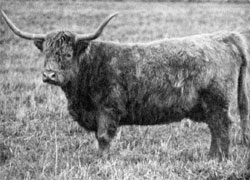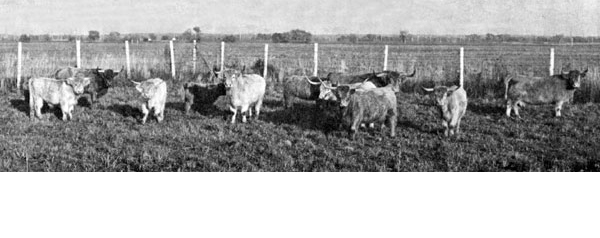James Bannisters give rare cattle herd to U.R.A.
Now grazing on a 20-acre pasture at the National Accelerator Laboratory is a herd of twelve Scottish Highland cattle, a gift to Universities Research Association, Inc. (URA), Washington, D.C., the corporation of 52 universities which operates the Laboratory for the U.S. Atomic Energy Commission. The cattle are a gift to U.R.A. by Mr. and Mrs. James Bannister of Wind Hill Farm, St. Charles, IL. The gift reveals the love of two people for these animals as well as the story of their interest in the development of the National Accelerator Laboratory.
When James Bannister's parents emigrated to America from Scotland, among the personal treasures that came with them was a large oil painting of a pastoral Scottish scene. Young Bannister carried vivid memories as he grew up of the shaggy, long-horned cattle in that painting. Many years later those memories were literally brought to life for Jim and his wife, Delta, a professor of dance education at Northwestern University who also loved the painting in the elder Bannisters' home. Delta discovered the shaggy beasts of the painting living on a ranch in the South Dakota Badlands as she traveled to their summer home near Jackson Hole, Wyo. in 1965. On their next trip West a few months later, it was inevitable that they should purchase their first three Scottish Highland cattle. "Mr. Badlands," "Miss Dusty," and "Princess Shirley" came to the Bannisters' 10-acre farm in St. Charles soon after, where a pine grove gave them protection from the hot sun of the summer.
For nine years the trio and their offspring basked in the comforts of the Bannisters' care and attention. They were, with certainty, part of the family. The friendly, gentle animals responded to particular words and commands like "Turn Around." Mr. Badlands was a "total gentleman," according to Delta Bannister. The herd ... was a delight to passersby on Dean Street. Their thick hair ... was groomed regularly, and they learned to arch their heads upward so that Delta could stroke the full length of their necks. But as the numbers grew, Delta had to stop this delightful practice - the clamor for a place in line, right behind Mr. Badlands with his 42-inch horn spread - was not conducive to Delta's welfare.
An increasing family of twelve created problems for these "parents" with many, varied interests. The decision to part with the loyal band came to the Bannisters last Fall. But, they could not go the usual market route with these close friends.
Once before Jim Bannister had participated in development of the National Accelerator Laboratory. Executive Director of the Fox Valley General Contractors Association and a Harvard alumnus, he was appointed in 1967 to be a member of the "Site Acquisition Committee," a group of distinguished advisers to the State of Illinois for the acquisition of the 6,800 acres in DuPage-Kane counties as a site for the National Accelerator Laboratory. Jim knows the NAL site very well from his experience on that committee. He recalls that even then he thought it an ideal place for a herd of Scottish Highland cattle. He followed NAL development in recent years closely enough to know of the interest the Laboratory has in preserving the natural aspects of the site. He knew of the NAL buffalo. He felt that his unique 4-legged friends might fit in well at NAL. The Bannisters contacted Laboratory Director R. R. Wilson about the matter, and their agreement followed shortly.
"We are happy to have found a place nearby where we feel the cattle will be enjoyed by many people," the Bannisters announced. "It is with great pleasure that we make this gift to URA and to the National Accelerator Laboratory which we helped get underway five years ago."
Scottish Highland cattle were first brought to the U.S. in 1922. There are about 12,000 head of registered Scottish Highland cattle in the U.S. at the present time. They are characterized by shaggy long hair and very widespread horns. The Bannisters found the horns to be an integral part of their cattle's personalities; their unique defense mechanism permits them to be gentle and sensitive personalities. They are kept as registered stock primarily by hobbyists and commercially with other beef animals. They are rugged, survive all climates, live longer lives than most beef cattle. "Scotty" calves are small at birth, but grow rapidly on the cows' 10% butterfat milk. Bannisters' cattle are yellow, white, silver, and red; in Scotland, this breed is red, yellow, or black. Because of their heavy hair, they do not accumulate the layer of fat under the skin as is the case with most beef animals. Their meat is not as marbled by fat and so, in this day of weight watchers and cholestrol counters, it is highly desirable.
"We are very pleased to accept this gift from the Bannisters. We know that the public will enjoy this new addition and these interesting animals will remind all of us of the Bannisters' friendship and service to the Laboratory," Donald R. Getz, Assistant Director of NAL, announced.
The Bannister herd consists of Mr. Badlands, two yearling bulls, a bull calf, seven cows and heifers, and a heifer calf. The two youngest animals, a bull calf and a heifer calf, have been named "Bannister" and "Rebecca" (of Ivanhoe) in honor of the donors. All of the animals carry the distinctive names characteristic of registered stock. The herd will be retained as a registered stock herd, according to NAL officials.





